1984 - 1996: Consolidation of Power
The Mighty Wintel Empire
The infamous quote "There is no reason anyone would want a computer in their home" by Digital Equipment Corporation founder Ken Olsen in 1977 is a perfect study of the prevailing corporate attitude towards personal computing in the early years.
Computers were mainframes, and minicomputers that could cost up to a million dollars were often sold in single digit numbers (per month), not to mention their initial hardware cost represented only a fraction of the overall upgrade and service contract.
The environment in the decades before the microprocessor revolution were convivial and fraternal regarding the sharing of ideas and inventions. Between the low expectations of the companies involved and the need for early allies to create a broad base of support for the budding industry, the early days of the PC saw a spirit of cooperation that has so completely eroded it is hard to believe it ever existed.

Ken Olsen, co-founder of Digital Equipment Corporation (DEC), a true stalwart of the early days of the PC. Even though he's infamously quoted about computers not needed in every home, it's said this was taken out of context. It hasn't affected his legacy either.
As the integrated circuit industry became more lucrative, former colleagues that had started out in a close knit community created an industrial diaspora as ideas and applications (and the lure of wealth) began to exceed the existing company's ability to bring them to fruition. Small companies that started out with camaraderie and enthusiasm soon became the monoliths that had prompted many to leave their previous jobs.
Intel could trace its existence to the breakup of Shockley Electronics and Fairchild Semiconductor, the departure of Federico Faggin and Ralph Ungermann to start Zilog, as well as David Stamm and Raphael Klein who left to found Daisy Systems and Xicor Incorporated, respectively.
Intel's Andy Grove was determined not to see his company gutted as Fairchild was. Lawsuits became object lessons to those employed at Intel, as a means of protecting its IP (which Fairchild had failed miserably at) and a method of tying up a competitor's financial resources while delaying its time to market for products.
Intel could trace its existence to the breakup of Shockley Electronics and Fairchild Semiconductor. Determined to avoid the same fate, lawsuits became object lessons to employees, a means of protecting its IP, and a method of tying up a competitor's financial resources.
Some of these suits were completely justified. More than a few competitors saw the success of the 8088/8086 as an invitation to directly copy Intel's design including NEC, who subsequently won the second legal battle when it defended its reverse engineered 8086 clone V series, while some became use of the patent and legal system to wage economic war on competitors.
When a group of employees led by Gordon Campbell left to capitalize on the EEPROM market by starting Seeq Technology, Intel promptly sued the new company on Grove's order. At Arthur Rock's behest, the lawsuit also targeted the venture capital firm that had supplied the start-up capital, which oddly enough included Intel's Gordon Moore as an investor. Funds poured into both Seeq and the legal defense, with a relatively peaceful resolution being reached through the moderating influence of Intel's chief legal counsel, Roger Bovoroy, after Seeq had stepped into a legal minefield regarding talk of a licensing arrangement with Zilog.
The next major conflict turned into the longest running and most acrimonious battles in the industry, and it occurred in large part because moderating influences were nowhere to be seen. Bovoroy had left Intel, and of the eight original founders of AMD, only Jerry Sanders remained – chip architect and voice of reason Sven-Erik Simonsen being the last to depart.

Jerry Sanders led AMD for over thirty years and earned a reputation as a charismatic, outspoken CEO (Robert Cardin)
Intel's relationship with AMD became openly hostile in September 1984 when the press asked Jerry Sanders how AMD got its Intel-licensed EEPROMs to market faster than Intel had itself. Sanders began a lengthy tirade on Intel's lack of manufacturing ability.
With Intel anxious to get rid of AMD as a second source partner for the 386, Sanders' outburst added an ignition source to an already volatile situation. The present agreement called for a cross-license of product, but Intel declined AMD's offers (a storage controller and a graphics chip, the Quad Pixel Display Manager), forcing AMD to make up the shortfall in royalties to Intel for its 286 license.
Litigation started in 1987 with AMD claiming there to have been a breach of contract. Intel responded with a countersuit for copyright infringement (Intel's 287 FPU), followed by an antitrust suit from AMD and then a second copyright suit by Intel over AMD's AM486 IP.
Both sides won their respective suits and some sense of order had been restored by 1995. AMD received $10 million and the rights to build the 386 in 1993 as well as $18 million with the rights build the 486 and outsource up to 20% of its x86 production, while Intel received $58 million from AMD for patent infringements.
More importantly for Intel, it stalled AMD's growth during a boom period of microprocessor growth and personal computing in particular. At a time when AMD was looking to take the next step to higher echelons of semiconductor companies – albeit still relying heavily on licensed production – the company's expansion was severely curtailed. Worse was to follow for AMD as the original license agreement signed with Intel was due to expire on December 31, 1996.
As their original license agreement was set to expire, Intel negotiated a much tougher one where AMD would have no access to Intel's microcode after the 486 architecture and future AMD processors after the 586-class could not be compatible with Intel sockets.
Intel negotiated a much tougher agreement just before the old one expired. In exchange for the continued use of existing Intel IP, AMD would have no access to Intel's microcode after the 486 architecture and future AMD processors after the 586-class could not be compatible with Intel sockets. This effectively meant that AMD was now racing against Intel's R&D timetable not just to produce its own processor architecture but also supporting chipsets and mainboards. Offering a cheaper alternative to an Intel CPU for what was otherwise an Intel-based system would no longer be enough.
For Intel, the AMD suits were just one of a number centering on the '338 patent, "the Crawford Patent", that it was pursuing in the early 1990s, including those against UMC (which Intel won) as well as Chips and Technologies and Cyrix, both of which ended with settlements.
The early years of the microprocessor industry, as with previous IC manufacture, were based on a vertically integrated model with the company both designing and manufacturing chips. The mid-80s ushered in the rise of the fabless semiconductor company who'd produce the design but outsource production to either an independent company who only fabricated chips (the pure-play foundry model pioneered by TSMC), or a design house with manufacturing ability who could produce chips for other companies if the IP was licensed and there was no conflict of interest.
A number of companies sprang up armed with technical knowledge but not the capital to invest in manufacture: NexGen (IBM), Cyrix (Texas Instruments, SGS-Thomson, IBM), Chips and Technologies (Hitachi and Toshiba), and Western Design Center being the most prominent. The list also includes Acorn, a small British company who began designing the Acorn RISC Machine processors (better known by the acronym ARM), to be fabricated by VLSI Technology.
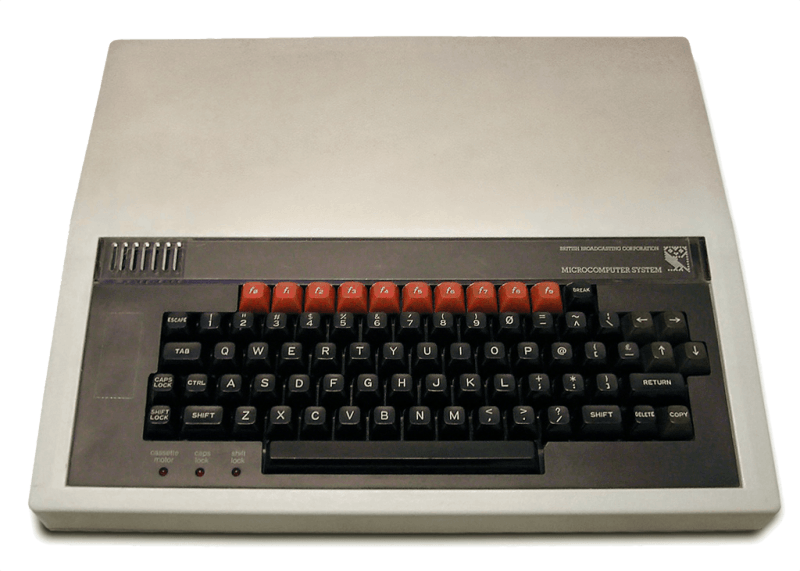
The BBC Micro was designed and built by Acorn Computer for the BBC Computer Literacy Project. The machine also served to simulate and develop the ARM architecture which is widely used in tablets and cellphones today.
None of the x86-based architecture companies lasted the distance, but they still contributed to the furtherance of the industry. Chips and Technologies was run on a shoestring budget but produced consolidated chipsets for the IBM PC-XT and its clones, vastly reducing the manufacturing cost as well as the first IBM compatible VGA graphics adapter which laid, the groundwork for the first wave of 2D graphics add-in board vendors.
Cyrix became a popular underdog in the processor market and combined excellent integer with mediocre floating-point performance like AMD's designs. A lengthy battle with Intel over the right to fabricate x86 designs drained resources and was made much worse by Cyrix's contract with foundry partner IBM who sold Cyrix-designed chips under the IBM name at lower cost.
An ailing Cyrix would be acquired by National Semiconductor in 1997 and onsold to VIA along with National's pre-existing x86 license with the exception of the MediaGX line which would end its days as Geode under the AMD banner.
NexGen would be a peripheral player in the CPU market as its chips, like Cyrix's, did not use Intel IP and were completely of its own design. Where Cyrix was pin-compatible with Intel sockets and thus had a ready market for the budget buyer, NexGen's Nx586 required its own 463-pin socket and NxVL chipset, which severely limited opportunities in the market once Intel's 430FX Triton chipset replaced the underperforming Neptune.
NexGen's market position was made all the more precarious by the rate of Intel's development and incremental clock speed increases along with the rapid devaluation of previous models. This would prove too rapid of change for the company. NexGen's follow up processor, the Nx686, would never see the light of day in that guise, as AMD bought the company when its own in house 686-class K6 project failed to meet performance goals. The final K6 that entered service would be a development of the NexGen design.
While the computer hardware business was being molded through vicious legal strategy, the battle for supremacy in the software market was no less intense. The success of the IBM PC and clones spawned three software empires almost overnight: Microsoft, Lotus, and Aston-Tate.
The battle for supremacy in software was no less intense. The success of the IBM PC and clones spawned three empires almost overnight: Microsoft, Lotus, and Aston-Tate.
The early huge success of VisiCalc had turned the two halves of the business into fierce opponents in the courtroom, a battle sparked primarily by the generous 37.5% royalty payment for retail and 50% for OEM copies that publisher Personal Software (later named VisiCorp) owed developer Software Arts. During the turmoil, Mitch Kapor, lead developer of two versatile add-ons for VisiCalc, VisiPlot and VisiTrend, sold his interest in the code to VisiCorp and set up Lotus Software. Banking on both IBM and Microsoft's DOS succeeding in the market, Kapor and programmer Jonathan Sachs developed Lotus 1-2-3.
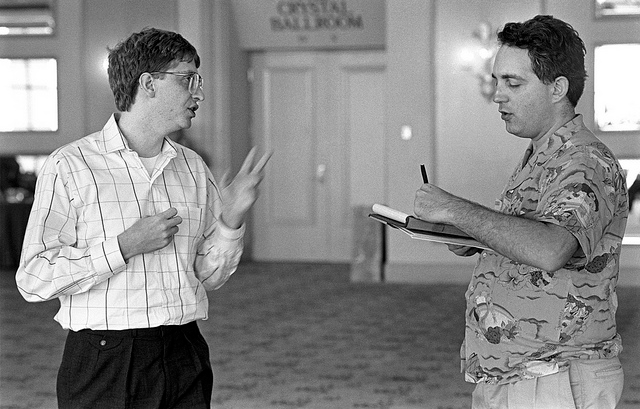
Bill Gates and Mitch Kapor, founder of Lotus Software (Cringley.com)
Lotus 1-2-3's IBM compatibility proved an outstanding success, becoming a compelling reason to purchase the IBM PC just as VisiCalc had with the Apple II. The spreadsheet program's success was in part due to coding specifically for the PC's Intel architecture.
Rival spreadsheet Context MBA was a more comprehensive software package but had been written in USCD's p-System to allow use with many architectures (a hedge against IBM and Microsoft failing in the market) at the cost of responsiveness due to the translation layer used to communicate with those dissimilar architectures.

Lotus 1-2-3 Release 3.0 for MS-DOS. (Wikipedia)
Lotus, as many companies before and since (including Intel), succumbed to second-system syndrome where a huge first product success brings pressure to follow up with a comparable or preferably, a bigger, better product. The company released the underwhelming Symphony and Jazz spreadsheet programs which failed to sustain the momentum gained by 1-2-3, and Lotus retreated from software innovation to the purchasing of IP.
As the company grew it fell into the pattern of litigating to maintain its position after Jim Manzi assumed the company presidency. A suit against Paperback Software in 1987 was won in June 1990, while others claiming Mosaic Software violated the "look and feel" of 1-2-3 in the software VP Planner and TheTwin were won in June 1990 and January 1991. Additionally, Borland Software was required to remove 1-2-3 macros from its Quattro Pro spreadsheet program.
What Lotus was to PC spreadsheet programs, Ashton-Tate would duplicate with dBase, its database software. Vastly successful at first, later versions would be successively less influential and the company's slide from prominence was accelerated by the death of founder George Tate, which saw the marketing-orientated Ed Esber become CEO. With the company's fortunes tied to a single product, Ashton-Tate purchased IP in the form of the Frameworks office suite from Forefront Corporation along with the MultiMate word processor program, but corporate disorganization geared on reaction rather than action doomed the company.
Lotus' fortunes waned as Microsoft claimed market after market.
Lotus' fortunes waned as Microsoft inexorably claimed market after market. A classic example would seem to be the case of Aldus' PageMaker desktop publishing program which was developed for integrating Apple's LaserWriter printer with the Macintosh computer. The success of the program led Aldus to develop a word processing program under the name Project Flintstone since early versions of PageMaker had no direct text input. Upon finding out the Flintstone was a year away from completion, Bill Gates demonstrated Microsoft's competitor Word for Windows to Aldus founder Paul Brainerd claiming that it would ship in six to nine months when in reality it was two years away from being published. Project Flintsone was summarily shelved.
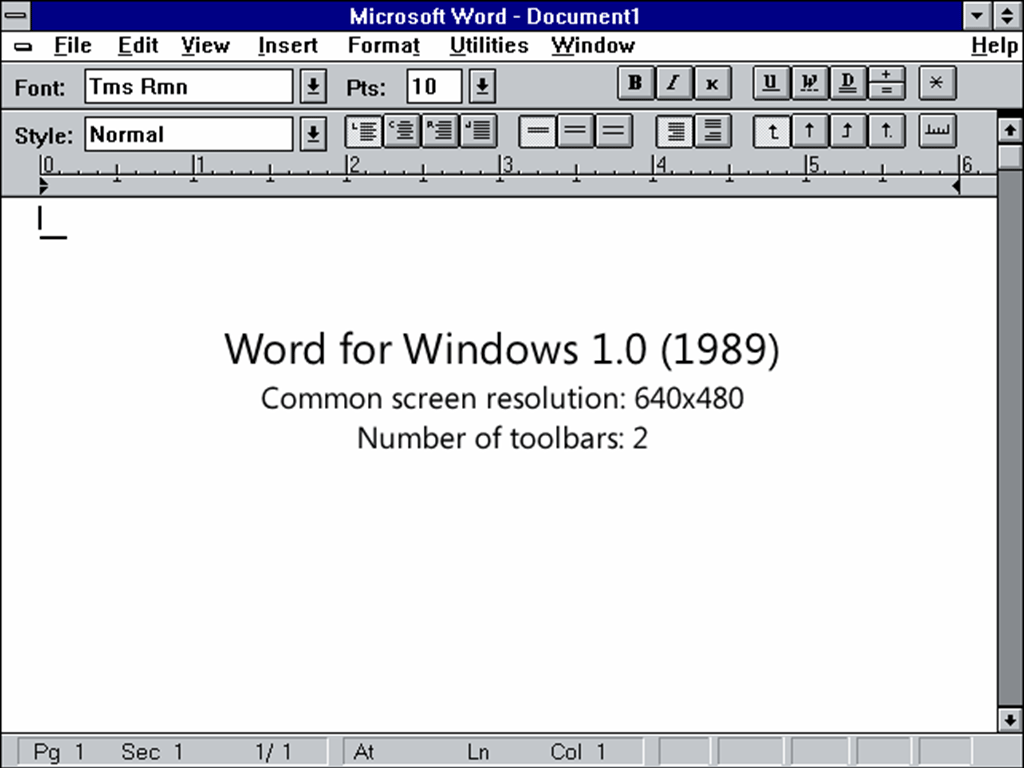
Though it certainly aided in the company's rise, Bill Gates' Microsoft survived not due to sleight of hand, but because it effectively separated management and administration from those producing the product. It had set clearly defined short, medium and long-term strategic goals, the longest being a reflection of Bill Gates' personality: to be number one.
Microsoft had grown at a prodigious rate thanks to IBM, but by the late 80s it was becoming apparent that while IBM was under attack from a slew of more agile competitors, all of them relied on Microsoft's OS and supporting applications. The expansion of the computing market and its associated software from business platform to personal computing coincided with the growth of the Internet and its accessibility.
While IBM was under attack from a slew of more agile rivals, all relied on Microsoft's OS and supporting applications.
The system evolved from small, mostly closed and incompatible networks that were restricted to academics and developers. The adoption of common standards (notably TCP/IP and HTTP) and encouraging the commercialization of the Internet was up until that point largely government-funded. With the subsequent expansion of the net from research, data and time sharing into a reflection of what the average consumer wants (email, online shopping, and interaction with a larger community), web browsers became big business.
Of the first wave of browsers, the NCSA's Mosaic was the most successful and was licensed to many companies. Mosaic developer Marc Andreessen went on to found Netscape Communications, and Netscape Navigator rapidly became the overwhelming browser choice of consumers with over 80% market share within the first year of introduction.
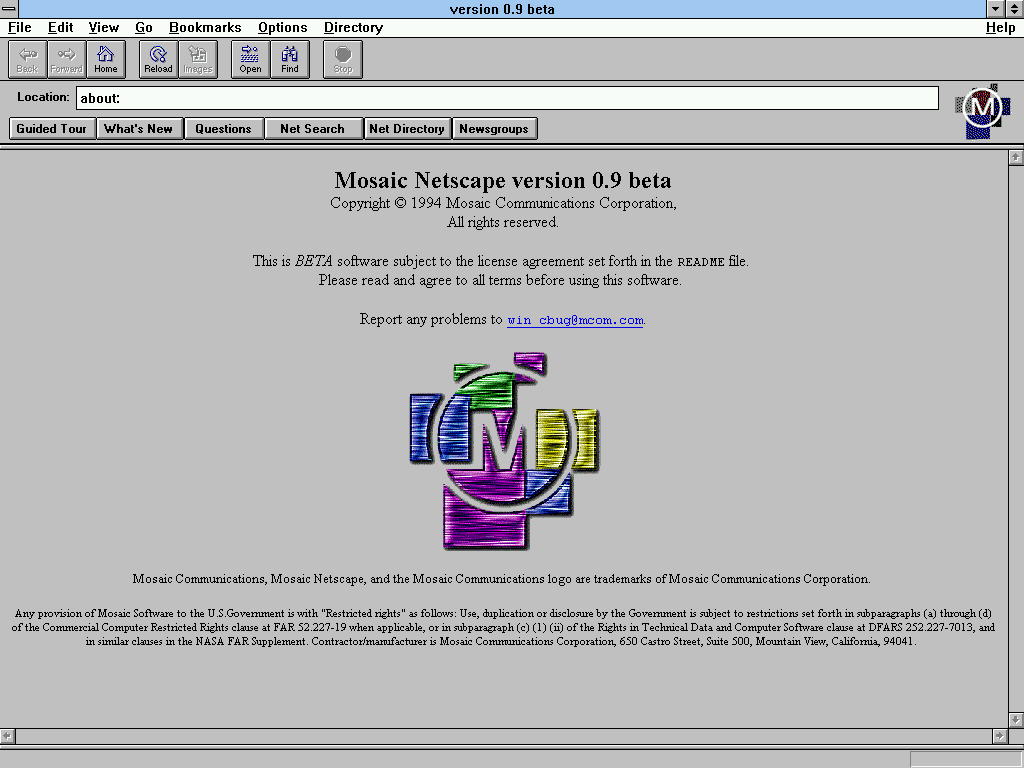
Microsoft's answer was to license a version of Mosaic from Spyglass to produce Internet Explorer but uptake was slow until the company made the decision to bundle IE with the Windows 95 operating system as a free application, instantly increasing its visibility and cutting royalties to Spyglass to just the base license fee.
Microsoft would later pay Spyglass $8 million to avert legal action. However, it wound up facing long running anti-trust proceedings brought by the European Union and U.S. Department of Justice anyway for including IE with Windows, for making it difficult to use a third-party browser with Windows and for making threats to withdraw Compaq's Windows licensing after Compaq's decision to bundle Netscape Navigator with its systems.
The decision to bundle IE with Windows enabled Microsoft to eclipse Netscape's market share in three years. By 2002 IE usage had peaked at nearly 96% and would remain the industry leader for another decade until a fundamental shift in the perception of personal computing would alter the balance of power.
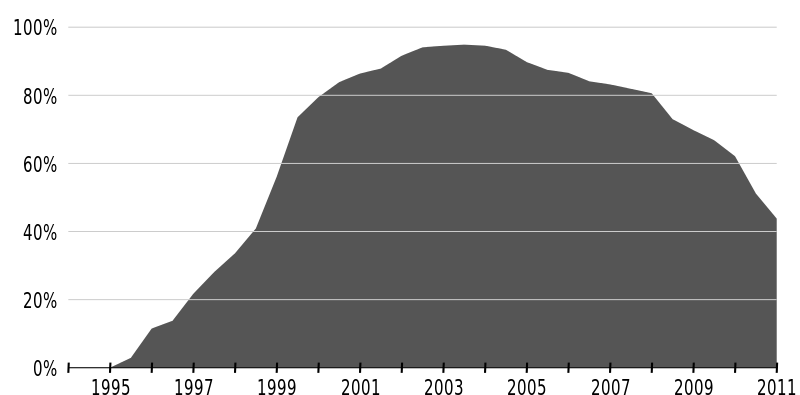
Internet Explorer historical usage data (Wikipedia)
That shift was a result of making the personal computer more personal as people discovered that computing was less a static workstation than it was a constant companion. If not for work, then mobile computers could certainly be used for entertainment, fashion accessory, and in some cases psychological need.
Mobile personal computing began at the low end of the spectrum with calculators, while "portable" more accurately meant "luggable" given the bulk of early components such as CRT screens and floppy disc drives as well as the general standard for miniaturization of the time. The first wave of true laptop designs were very expensive business status symbols conforming to an Intel processor powered system with a half-clamshell non-backlit LCD screen usually capable of displaying four to eight lines of text, although the Hewlett-Packard HP-110 also included a 480x120 pixel graphics mode (480x200 with the HP-110 Plus), while the GriD Compass 1101 managed 320x240 for its $8,000 to $10,000 price tag.
Cheaper, less featured models also poured into the market from a host of manufacturers such as Epson (HX-20), Sharp (PC-5000), and Kyocera, whose Kyotronic 85 was also licensed out to Olivetti, Tandy, and NEC. The reduced feature set stemmed in large part from the need for cheap low power processors, something that would be addressed as Intel introduced 386SL model from 1990, some four years after the 386 debuted.
Intel would spend $100 million in developing the 386, but the industry in general was in love with the 286 thanks to its low cost and the number of vendors offering versions of the chip. With a manufacturing cost of $141, up from $34 for the 286, the 386's price of $900 represented a sizeable increase in expenditure for an industry not quite ready for 32-bit computing.

The PS/2 was IBM's attempt to recapture control of the PC market by introducing an advanced yet proprietary architecture. Manufacturers stuck to "Wintel" solutions but many PS/2 innovations went on to become standards.
Intel's "Red X" campaign was design to bypass system builders and get consumers to identify their computing needs by the manufacturer of the processor.
Compaq's DeskPro 386 and ALR's Access both debuted in September 1987, a full seven months before IBM's PS/2 underlined IBM's fading status. With Microsoft publicly chafing at an industry clinging to 16-bit (and in some cases 8-bit) compatibility, the OEMs that usurped IBM's position had quickly found their place as a "market leader" was largely illusionary. Intel's "Red X" marketing campaign in October 1989 made a concerted effort to force the industry into 32-bit computing, bypassing system builders and appealing to the buying public.
Large full-page advertisements featuring the numbers 286 with a large red "X" sprayed over the top of them began a strategy to get consumers to identify their computing needs by the manufacturer of the processor.
The campaign was designed more to marginalize the 286 licensees (Harris, AMD, IBM, Fujitsu, and Siemens) as it was to sell Intel's 386s, and it quickly established in the consumer's mind that companies pushing the 286 (including Intel's own OEM partners) were selling obsolete technology while elevating Intel's brand as market leader.

Early Intel Inside Ad 386sx (Flickr user intelphotos)
The Red X campaign presented obvious proof that Intel had little need for second source partners and belatedly spurred the x86 chip producers into making their own 386-class chips. The mark of AMD's design and manufacturing prowess was shown with the first 18 six-inch wafers, which were ready by August 1990 and yielded only a single defective Am386 die.
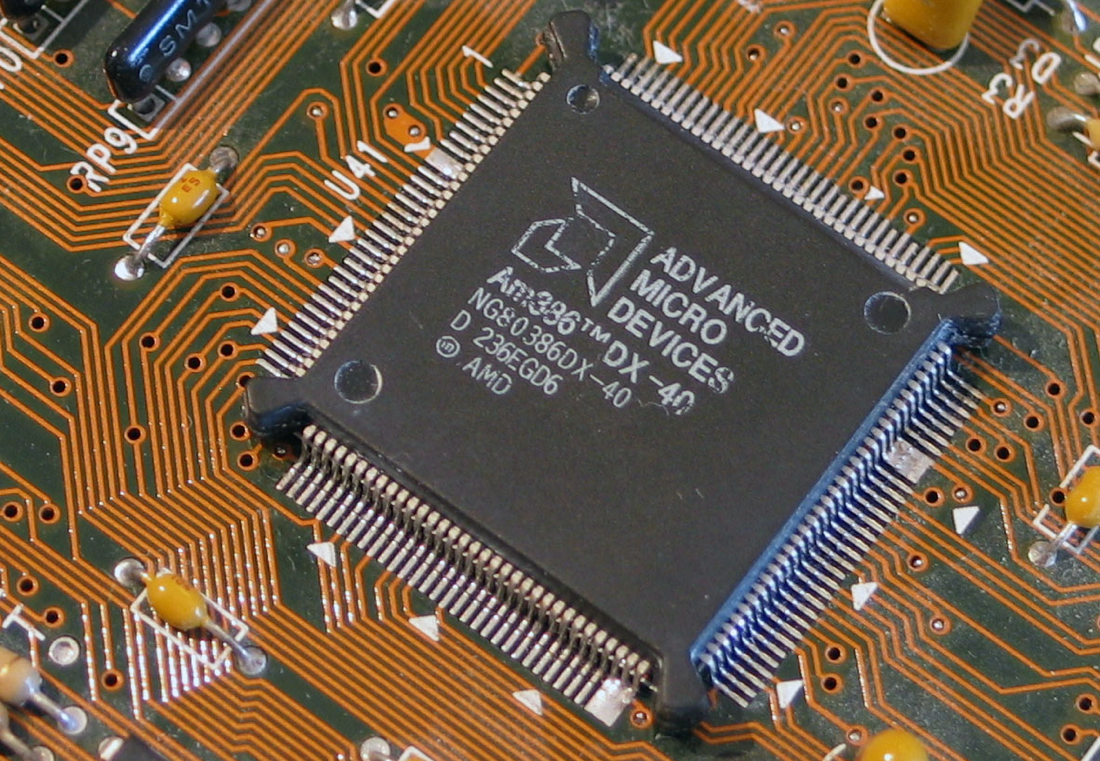
Between March 1991 and the end of the year the Am386 racked up $200 million from sales of two million processors, gaining a 14% share of the market, while another two million were sold in the first three months of 1992. Sales would remain buoyant even as Intel transitioned to the 486, which came in a number of guises including both 32-bit and 16-bit external/32-bit internal varieties in addition to Overdrive models, but sales hid a larger truth.
The 386 had required four and a half years to achieve a 25% market share while the 486 achieved the same in one year less, with the impending Pentium likely to better that by a considerable margin (it would achieve the feat in 18 months).
The Pentium era would see Intel distance itself from competitors and elevating its brand to consumers directly by adopting a copyrightable model name. The company would capitalize and expand on Red X marketing with their long running "Intel Inside" campaign that made Intel's brand the common identifier when the consumer was faced with a variety of system vendors. The program included TV advertising with its soon to be well-known five-note jingle as well as subsidized advertising for vendors who highlighted Intel's brand during the advertisement.

Early Intel Inside ad "Spot Intel" (Flickr user intelphotos)
Within three years, 1200 companies joined the campaign and the combined exposure elevated Intel's sales 63% in the first full year of operation. Less publicized would be the company's move into component manufacturing when it committed to building its own motherboards, driving hundreds of board manufacturers from the market while raising quality assurance levels with the OEMs who sourced the components.
The Pentium era would see Intel distance itself from competitors and elevating its brand to consumers directly by using a copyrightable model name.
Such was the program's success that the OEM became a secondary consideration after choice of processor for many shoppers – a complete reversal in five years, assuming many consumers prior to 1989 actually had any preference in CPU manufacturer. AMD in particular from this point forward would be battling against the Intel brand as much as Intel technology, but they would be far from the only companies under threat.
Apple and IBM joined by Motorola formed the AIM alliance in July 1991 to develop a commercial PowerPC RISC-based architecture as an alternative to the growing influence of x86 "Wintel" solutions. IBM would also hedge its bets by entering into a 10-year joint venture with Intel in November of the same year to develop processors. The big loser in the power struggle would be DEC's promising Alpha XP 64-bit RISC architecture. Being declined by IBM as a developmental choice followed DEC's own decision to decline Apple's invitation to use the 21064 in future Macintoshes five months earlier.
All of Intel's efforts could have been wiped out with Dr. Thomas Nicely's discovery of errors in the Pentium processors lookup table during June 1994, a little more than a year after the architecture's introduction. Adverse publicity stemming from Dr. Nicely's lack of received support from Intel caused the issue to enter the mainstream via a CNN television report.
Intel's official response was that all chips carry errors. In recent times, 50,000 of its own 486s had been turned into key rings and Cyrix had halted production of its 486DX to fix a floating-point bug, but Intel, recently elevated into the public eye, was under the scrutiny of consumers who expected a defective product to be replaced, regardless of what it was.
The murmur of discontent became a clamor as IBM suspended Pentium shipments, and Intel's response was decisive in the face of the earlier equivocation. Intel chose to maintain its brand over immediate profit, offering a public apology and a replacement processor to affected customers. Intel sustained a $475 million write-down on a million affected processors, but averted a big loss in marketing momentum.
The Pentium FDIV bug, while referenced frequently by detractors, barely caused a ripple in the market, with Intel recording a 31% growth in overall semiconductor sales the following year and its CPU market share rising to 77% worldwide by units and 82% by revenue. As Intel subsumed the motherboard market, it also began relegating chipset manufacturers into also-ran status.
Of the 76 million chipsets shipped in 1995, Intel contributed a mere 1.5 million while SiS, VIA, OPTi, and Acer Labs (ALi) produced almost 33 million between them.
By the end of 1996, Intel's new motherboard business enabled chipset production to account for 40 million of the 71.4 million total produced, dooming low-end chipset manufacturers to early retirement and raising the overall quality of available components (there was a thriving market for cheap boards using grossly overstated specification – in some cases even non-functional fake components).
Intel's motherboard business doomed low-end chipset manufacturers to early retirement and raised the overall quality of available components.
Eventually AMD managed to get its 586-class processor into the market in March 1996. Announced the previous September as '30% faster than the Pentium' on a clock for clock basis, the design fell far short of the rhetoric as well as the competing Cyrix 6x86. The planned K5 name was dropped in favor of SSA/5 prior to its release. After the CPU core and cache structure were reworked, the second wave (and first to use the K5 name) shipped in October 1996.
Much improved, it still did little to motivate sales. As with Cyrix's part, AMD's tended to generate more heat than the Pentium, limiting its appeal to overclockers. AMD's follow up, the K6, proved to be what the previous design had aspired to.

The K6 was based on the Nx686 microprocessor that NexGen was designing when it was acquired by AMD (Wikipedia)
With Intel beginning to ship Pentium II samples to OEM vendors the month before, AMD's K6 launch in April 1997 provided much needed marketing exposure and enabled the company to cease production of the K5 within a few months.
High-profile orders from DEC for the Venturis FX-2 and from IBM for the budget Aptiva line would help bring the K6 into the market. However, overall market share would slip to under 10% in large part due to Intel's mobile Pentium sales and a strong overall last quarter leading into the holiday season where AMD's 4.4% of sales paled against Intel's 91.1%.
AMD's 586-class processor fell far short of its faster-than-Pentium rhetoric and a reworked, much improved revision did little to motivate sales. The follow up K6 finally proved to be what the previous design had aspired to.
The arrival of the "Chomper" K6-II in May 1998 would lift AMD to 12% of x86 sales for the year as personal computer sales broke through the 100 million barrier. The K6-II would dominate the sub-$1,000 desktop market with its improved performance and friendly price tags (the 366MHz version started at $187), outselling Intel's Celeron and Cyrix's MII combined two to one in its first full quarter of availability.
By the late 1980s, personal computing was seeing the full effects of the economies of scale. CPUs and chipsets consolidated the function of many individual integrated circuits into fewer and more cost effective parts while processors exhibited enough speed that a range of capable CPUs was available via binning and speed reduction for low-power mobile and low-cost products.
The limiting factor in growth became the ability to manufacture the chips fast enough to satisfy demand. Sales of personal computers grew in excess of 10% a year on the back of home productivity applications and the developing 3D graphics market, which had begun blooming with the arrival of the 3dfx Voodoo Graphics board and major games such as Valve's Half-Life in 1998.
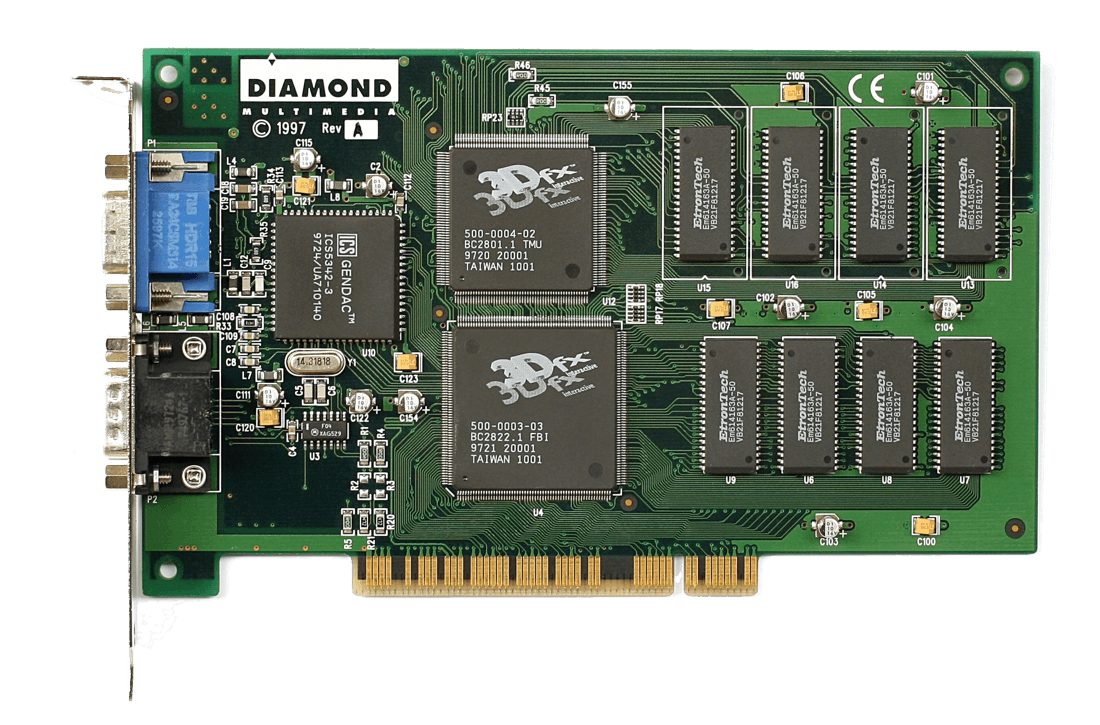
A sign of the shift in personal computing arrived on February 8, 1999, when Free-PC announced its campaign offering free Compaq PCs with Internet access in exchange for usage tracking and on-screen advertising. By the time the campaign finished in February 2000, 25,000 customers had signed up and many small computer sales companies had been put out of business.
The direct model of shaping the internet and those who use it would in the future become more indirect as personal computing moved into the new millennium.
This article is the fourth installment on a series of five. If you enjoyed this, read on as we wrap up the series with a little more on the Intel-AMD rivalry and ARM's role in bringing personal computing to the next step in its evolution.
Header image via Flickr user creative_stock
